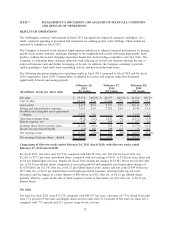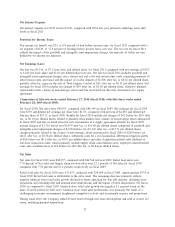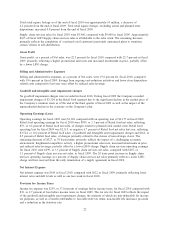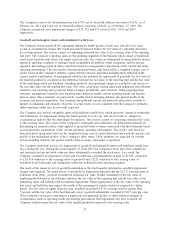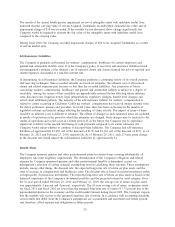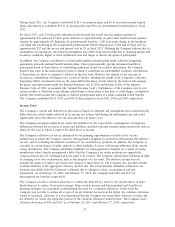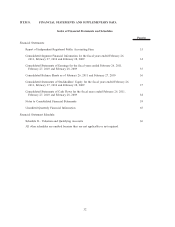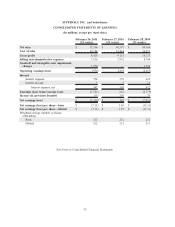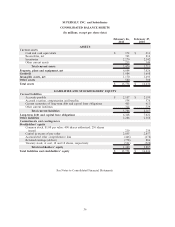Albertsons 2011 Annual Report Download - page 31
Download and view the complete annual report
Please find page 31 of the 2011 Albertsons annual report below. You can navigate through the pages in the report by either clicking on the pages listed below, or by using the keyword search tool below to find specific information within the annual report.During fiscal 2011, the Company contributed $163 to its pension plans and $6 to its postretirement benefit
plans, and expects to contribute $70 to its pension plans and $8 to its postretirement benefit plans in fiscal
2012.
For fiscal 2012, each 25 basis point reduction in the discount rate would increase pension expense by
approximately $10 and each 25 basis point reduction in expected return on plan assets would increase pension
expense by approximately $4. Similarly, for postretirement benefits, a 100 basis point change in the healthcare
cost trend rate would impact the accumulated postretirement benefit obligation as of the end of fiscal 2011 by
approximately $12 and the service and interest cost by $1 in fiscal 2012. Although the Company believes that its
assumptions are appropriate, the actuarial assumptions may differ from actual results due to changing market and
economic conditions, higher or lower withdrawal rates and longer or shorter life spans of participants.
In addition, the Company contributes to various multi-employer pension plans under collective bargaining
agreements, primarily defined benefit pension plans. These plans generally provide retirement benefits to
participants based on their service to contributing employers. Based on available information, the Company
believes that some of the multi-employer plans to which it contributes are underfunded. Company contributions
to these plans are likely to continue to increase in the near term. However, the amount of any increase or
decrease in contributions will depend on a variety of factors, including the results of the Company’s collective
bargaining efforts, investment return on the assets held in the plans, actions taken by the trustees who manage
the plans, and requirements under the Pension Protection Act of 2006 and Section 412(e) of the Internal
Revenue Code of 1986, as amended (the “Internal Revenue Code”). Furthermore, if the Company were to exit
certain markets or otherwise cease making contributions to these plans at this time, it could trigger a withdrawal
liability that would require the Company to fund its proportionate share of a plan’s unfunded vested benefits.
The Company contributed $135, $143 and $147 to these plans for fiscal 2011, 2010 and 2009, respectively.
Income Taxes
The Company’s current and deferred tax provision is based on estimates and assumptions that could materially
differ from the actual results reflected in its income tax returns filed during the subsequent year and could
significantly affect the effective tax rate and cash flows in future years.
The Company recognizes deferred tax assets and liabilities for the expected tax consequences of temporary
differences between the tax bases of assets and liabilities and their reported amounts using enacted tax rates in
effect for the year in which it expects the differences to reverse.
The Company’s effective tax rate is influenced by tax planning opportunities available in the various
jurisdictions in which the Company operates. Management’s judgment is involved in determining the effective
tax rate and in evaluating the ultimate resolution of any uncertain tax positions. In addition, the Company is
currently in various stages of audits, appeals or other methods of review with taxing authorities from various
taxing jurisdictions. The Company establishes liabilities for unrecognized tax benefits in a variety of taxing
jurisdictions when, despite management’s belief that the Company’s tax return positions are supportable,
certain positions may be challenged and may need to be revised. The Company adjusts these liabilities in light
of changing facts and circumstances, such as the progress of a tax audit. The effective income tax rate
includes the impact of reserve provisions and changes to those reserves. The Company also provides interest
on these liabilities at the appropriate statutory interest rate. The actual benefits ultimately realized for tax
positions may differ from the Company’s estimates due to changes in facts, circumstances and new
information. As of February 26, 2011 and February 27, 2010, the Company had $182 and $133 of
unrecognized tax benefits, respectively.
The Company records a valuation allowance to reduce the deferred tax assets to the amount that it is more-
likely-than-not to realize. Forecasted earnings, future taxable income and future prudent and feasible tax
planning strategies are considered in determining the need for a valuation allowance. In the event the
Company was not able to realize all or part of its net deferred tax assets in the future, the valuation allowance
would be increased. Likewise, if it was determined that the Company was more-likely-than-not to realize the
net deferred tax assets, the applicable portion of the valuation allowance would reverse. The Company had a
valuation allowance of $24 and $161 as of February 26, 2011 and February 27, 2010, respectively.
27




